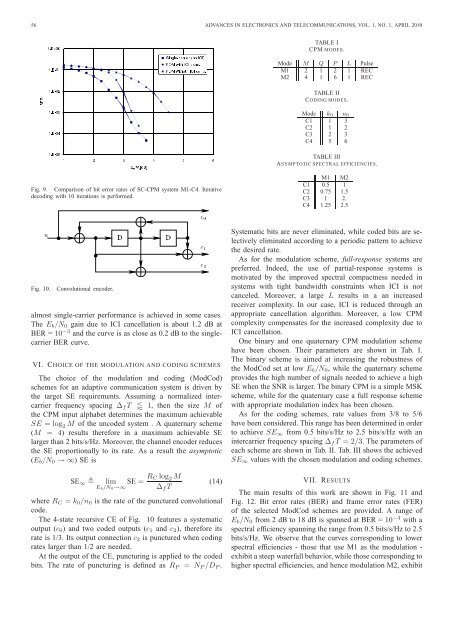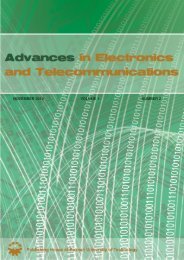channel - Advances in Electronics and Telecommunications
channel - Advances in Electronics and Telecommunications
channel - Advances in Electronics and Telecommunications
Create successful ePaper yourself
Turn your PDF publications into a flip-book with our unique Google optimized e-Paper software.
56 ADVANCES IN ELECTRONICS AND TELECOMMUNICATIONS, VOL. 1, NO. 1, APRIL 2010<br />
Fig. 9. Comparison of bit error rates of SC-CPM system M1-C4. Iterative<br />
decod<strong>in</strong>g with 10 iterations is performed.<br />
Fig. 10. Convolutional encoder.<br />
almost s<strong>in</strong>gle-carrier performance is achieved <strong>in</strong> some cases.<br />
The Eb/N0 ga<strong>in</strong> due to ICI cancellation is about 1.2 dB at<br />
BER = 10 −3 <strong>and</strong> the curve is as close as 0.2 dB to the s<strong>in</strong>glecarrier<br />
BER curve.<br />
VI. CHOICE OF THE MODULATION AND CODING SCHEMES<br />
The choice of the modulation <strong>and</strong> cod<strong>in</strong>g (ModCod)<br />
schemes for an adaptive communication system is driven by<br />
the target SE requirements. Assum<strong>in</strong>g a normalized <strong>in</strong>tercarrier<br />
frequency spac<strong>in</strong>g ∆f T � 1, then the size M of<br />
the CPM <strong>in</strong>put alphabet determ<strong>in</strong>es the maximum achievable<br />
SE = log 2 M of the uncoded system . A quaternary scheme<br />
(M = 4) results therefore <strong>in</strong> a maximum achievable SE<br />
larger than 2 bits/s/Hz. Moreover, the <strong>channel</strong> encoder reduces<br />
the SE proportionally to its rate. As a result the asymptotic<br />
(Eb/N0 → ∞) SE is<br />
SE∞ � lim<br />
Eb/N0→∞ SE = RC log 2 M<br />
∆f T<br />
(14)<br />
where RC = k0/n0 is the rate of the punctured convolutional<br />
code.<br />
The 4-state recursive CE of Fig. 10 features a systematic<br />
output (c0) <strong>and</strong> two coded outputs (c1 <strong>and</strong> c2), therefore its<br />
rate is 1/3. Its output connection c2 is punctured when cod<strong>in</strong>g<br />
rates larger than 1/2 are needed.<br />
At the output of the CE, punctur<strong>in</strong>g is applied to the coded<br />
bits. The rate of punctur<strong>in</strong>g is def<strong>in</strong>ed as RP = NP /DP .<br />
TABLE I<br />
CPM MODES.<br />
Mode M Q P L Pulse<br />
M1 2 1 2 1 REC<br />
M2 4 1 6 1 REC<br />
TABLE II<br />
CODING MODES.<br />
Mode k0 n0<br />
C1 1 3<br />
C2 1 2<br />
C3 2 3<br />
C4 5 6<br />
TABLE III<br />
ASYMPTOTIC SPECTRAL EFFICIENCIES.<br />
M1 M2<br />
C1 0.5 1<br />
C2 0.75 1.5<br />
C3 1 2.<br />
C4 1.25 2.5<br />
Systematic bits are never elim<strong>in</strong>ated, while coded bits are selectively<br />
elim<strong>in</strong>ated accord<strong>in</strong>g to a periodic pattern to achieve<br />
the desired rate.<br />
As for the modulation scheme, full-response systems are<br />
preferred. Indeed, the use of partial-response systems is<br />
motivated by the improved spectral compactness needed <strong>in</strong><br />
systems with tight b<strong>and</strong>width constra<strong>in</strong>ts when ICI is not<br />
canceled. Moreover, a large L results <strong>in</strong> a an <strong>in</strong>creased<br />
receiver complexity. In our case, ICI is reduced through an<br />
appropriate cancellation algorithm. Moreover, a low CPM<br />
complexity compensates for the <strong>in</strong>creased complexity due to<br />
ICI cancellation.<br />
One b<strong>in</strong>ary <strong>and</strong> one quaternary CPM modulation scheme<br />
have been chosen. Their parameters are shown <strong>in</strong> Tab. I.<br />
The b<strong>in</strong>ary scheme is aimed at <strong>in</strong>creas<strong>in</strong>g the robustness of<br />
the ModCod set at low Eb/N0, while the quaternary scheme<br />
provides the high number of signals needed to achieve a high<br />
SE when the SNR is larger. The b<strong>in</strong>ary CPM is a simple MSK<br />
scheme, while for the quaternary case a full response scheme<br />
with appropriate modulation <strong>in</strong>dex has been chosen.<br />
As for the cod<strong>in</strong>g schemes, rate values from 3/8 to 5/6<br />
have been considered. This range has been determ<strong>in</strong>ed <strong>in</strong> order<br />
to achieve SE∞ from 0.5 bits/s/Hz to 2.5 bits/s/Hz with an<br />
<strong>in</strong>tercarrier frequency spac<strong>in</strong>g ∆f T = 2/3. The parameters of<br />
each scheme are shown <strong>in</strong> Tab. II. Tab. III shows the achieved<br />
SE∞ values with the chosen modulation <strong>and</strong> cod<strong>in</strong>g schemes.<br />
VII. RESULTS<br />
The ma<strong>in</strong> results of this work are shown <strong>in</strong> Fig. 11 <strong>and</strong><br />
Fig. 12. Bit error rates (BER) <strong>and</strong> frame error rates (FER)<br />
of the selected ModCod schemes are provided. A range of<br />
Eb/N0 from 2 dB to 18 dB is spanned at BER = 10 −4 with a<br />
spectral efficiency spann<strong>in</strong>g the range from 0.5 bits/s/Hz to 2.5<br />
bits/s/Hz. We observe that the curves correspond<strong>in</strong>g to lower<br />
spectral efficiencies - those that use M1 as the modulation -<br />
exhibit a steep waterfall behavior, while those correspond<strong>in</strong>g to<br />
higher spectral efficiencies, <strong>and</strong> hence modulation M2, exhibit







